“Because touch, more than any other sense, has such ready access to young babies’ brains, it offers perhaps the best possible opportunity, and one of the easiest, for molding their emotional and mental well-being.”
What’s Going on in There? How the Brain and Mind Develop in the First Five Years of Life; Lise Eliot, PhD
What is Child’Space?
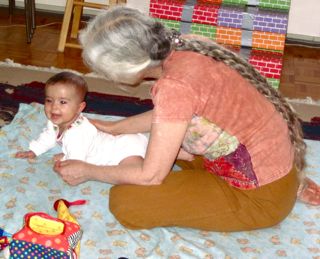 Child'Space Method assists parents and caregivers in learning how to support their child's development, especially during the first two years: the critical period from birth to the stage of independent walking. The method is based on stimulating the motor, cognitive, and mental systems involved in infant development. This work is effective for all infants including those with special needs or developmental delays . Child'Space Method assists parents and caregivers in learning how to support their child's development, especially during the first two years: the critical period from birth to the stage of independent walking. The method is based on stimulating the motor, cognitive, and mental systems involved in infant development. This work is effective for all infants including those with special needs or developmental delays .
Doesn’t my baby just develop naturally on her own?
|
Yes and No.
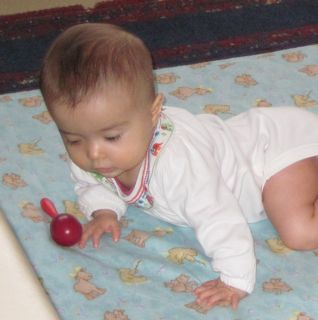
|
As human beings we are born with an innate intelligence, a capacity for organic learning and the ability to sense ourselves. We learn through movement, exploring our bodies and our environment using an internal sensory system. Because we have no idea what’s supposed to happen, we are open and playful, experimenting, moving randomly and our brain makes the connections and development happens. These connections are not preprogrammed. The brain makes them as the baby moves. Restricting this movement process prevents the brain from making the necessary connections. |
The Steps Inbetween the Milestones
It is important not to put too much emphasis on the 'Milestones' as they are really only the most eaily idetifiable movement points. Each baby accomplishes these at his/her own pace. It is the points in between that lend so much ease and grace to a baby's movement. Playing while lying on the side. Half on the front and half on the side. In all these positions your baby is practicing for her next step. During this floor play your baby is learning about eye-hand co-ordination, balance, how to use her body and her environment.
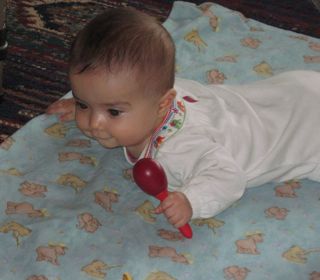
It is this play that prepares the way for sitting, crawling and walking. It is important for your baby to learn to lift and turn his head to both sides, roll easily to both sides, from front to back and back to front, come to sit on this own before being placed in a sitting position. Your baby needs to have sufficient development and strength in her back before being asked to hold up her head. This happens naturally in floor play.
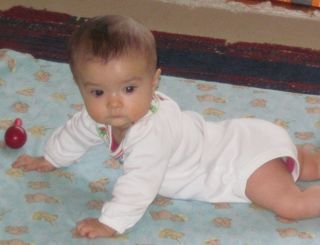 If your baby doesn't master these milestones and there is no medical reason it is usually because the baby is not given the floor time, stimulation and freedom of movement necessary for this process. Too much time in car seats, bouncy seats and swings and jolly jumpers often intervenes in a negative way preventing your baby from mastering movement. If your baby doesn't master these milestones and there is no medical reason it is usually because the baby is not given the floor time, stimulation and freedom of movement necessary for this process. Too much time in car seats, bouncy seats and swings and jolly jumpers often intervenes in a negative way preventing your baby from mastering movement.
The Challenge of Movement
Learning all of this is a challenge for most infants. It is important that your baby be supported during this time, but not rescued. When he is attempting to master something new it may be frustrating, and there are ways to support and offer minimal interevention that supports the learning. This is more benefitical than picking him up and removing the opportunity to master what he was playing with.
Who can benefit from this work and how is it taught?
|
Any parent who is concerned about their child's devlopment or just curious to know more about the developmental process their baby is going through.
It is easy, fun and satisfying to learn to support your baby as she approaches these new positions, to learn what interferes with her development and what supports it. This provides for a closer bonding and more confident parenting.
|
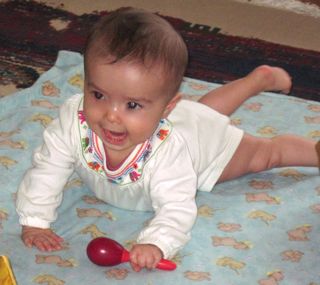 |
Why is developmental monitoring important?
The way in which infants perceive, organize and process information directly affects the development of movement skills and the way they relate to their environment. Monitoring and supporting an infant on this critical journey influences his/her physical, social, emotional and cultural adjustments throughout his/her life. In recent years, a growing number of children are requiring special education services even as early as kindergarten. Early intervention and stimulation of a child’s primary developmental pathways can prevent or alleviate some of the manifestations of impaired development that many in our society are experiencing.
How is ChildS'pace taught?
Child'Space is offered in small group classes or private lessons for parents and their babies. Mom and baby groups, new parents and expectant parents particularly benefit from this information.
Each session includes:
-
Hands-on instructive touch to develop baby's proprioception - the sense of the position and movement of one's body
-
Face to Face play to encourage focus, sound and communication
-
Analysis of baby's emerging developmental stage and activities to support current and emerging motor skills
-
Music, song and age-appropriate play to facilitate social relationships
-
Techniques for bonding, calming baby and carrying
For more information about ChildS'pace visit www.childspcemethod.com.
About Dr.Chava Shelhav
Dr. Chava Shelhav was one of Moshe Feldenkrais’ first students and she studied and worked with him from 1959 until his death in 1984. She holds a master’s degree from Boston University. and her thesis, "Working with Brain Damaged Children Using the Feldenkrais Method," was published in 1989. Her doctorate, from the University of Heidelberg in the Departments of Sociology and Life Sciences, examined the effects of the Feldenkrais Method on learning processes and other aspects of childhood. Child’Space evolved out her work with the Feldenkrais Method and her studies in early childhood development. For more information about Dr. Shelhav and her Child’Space work in Israel and Europe visit www.feldenkrais-shelhav.com.
|
 |
|